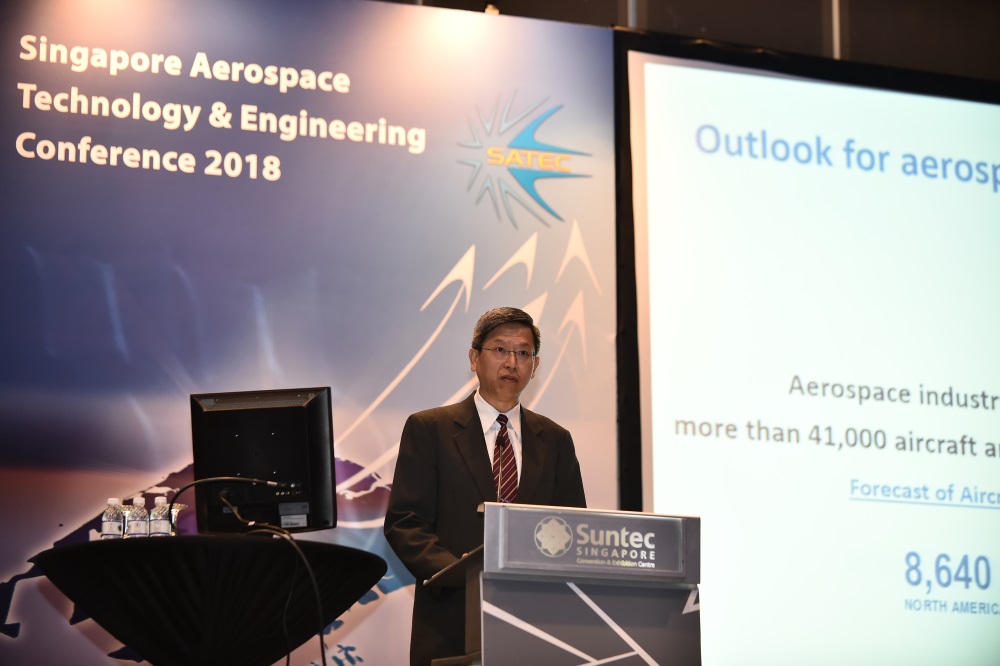INNOVATION A MUST FOR ALL IN AEROSPACE
// STORY Thrina Tham
// PHOTO Tan Yong Quan
These are examples of how innovation will drive the aerospace industry, as highlighted by Permanent Secretary (Defence Development) Neo Kian Hong at the Singapore Aerospace Technology and Engineering Conference (SATEC) on 7 Feb.
"The industry faces increasing pressures of shorter development cycle, and demand for efficiency and cost effectiveness," he said. "Even with new demands to enhance our defence capabilities, the Singapore Armed Forces (SAF) is mindful to keep (the) defence budget within our GDP growth rates.
"This means that the SAF has to be innovative in 'stretching our defence dollar', that is to adopt new management strategies and operating models," he said.
For example, the RSAF does not own the EC210 helicopters it uses in its Rotary Wing Course, but "leases" them from ST Aerospace, allowing the air force to save on operating cost.
Mr Neo was addressing about 450 defence officials, aerospace engineers, researches and industry leaders who attended the conference at Suntec Singapore Convention & Exhibition Centre.
Held in conjunction with the Singapore Airshow 2018, SATEC is a biennial conference jointly organised by Air Engineering and Logistics Department, Republic of Singapore Air Force (RSAF) and the Singapore Institute of Aerospace Engineers.
In addition to cost pressures, Mr Neo also observed emerging demands and new technology in the aerospace industry.
On emerging demands, operators will seek more fuel-efficient, specialised aircraft, along with cheaper and more sophisticated maintenance, said Mr Neo.
"Traditional maintenance, repair and overhaul (MRO) companies must find a way to collaborate and value-add."
On this front, ST Aerospace has developed digital capabilities, such as data analytics, to enable predictive maintenance of aircraft cabin parts. It also uses collaborative robotics - robots working alongside humans - to improve on engine repair and manufacturing.
Finally, the 4th Industrial Revolution will offer revolutionary technologies for the aerospace industry, said Mr Neo. This refers to technology breakthroughs in the areas of artificial intelligence, robotics and autonomous vehicles, among other fields.
One use of such technology is the advancement of flight simulators for pilot training - which can replace live training and drive down training cost.
The current F-35 Full Mission Simulator allows for up to 55 percent of initial flight training to be done virtually. This is a boost from the 40 percent of flight training simulation that can be conducted for an F-16 fighter jet.
Mr Neo also cited the growth of the Unmanned Aerial System (UAS) that is "becoming central to the regular functions of businesses and governments".
"The next generation UAS is already under way. They will have built-in safeguards, self-monitoring capability and the ability to fly without relying on GPS," he said.
His sentiments on the emergence of UAS was echoed by Air Chief Marshal Sir Stephen Dalton, President of The Royal Aeronautical Society, who spoke at SATEC as a distinguished guest speaker.
There needs to be greater integration of Unmanned Aerial Vehicles (UAVs) and manned platforms to be used in the same airspace, said Sir Dalton. "We've got some significant work to do, on how we do integration, how we detect how we keep it safe, as this becomes a norm rather than an exception."
On other considerations of introducing autonomous machines, Sir Dalton added: "We have to think about battery and power, about systems that are friendly to the environment.
"And we have to think about morally and socially how we are going to convince the public that its safe and 'the thing to do'."
Other topics discussed at SATEC included the 3D printing of aircraft parts and the building of network systems that are resistant against cyberattacks.










